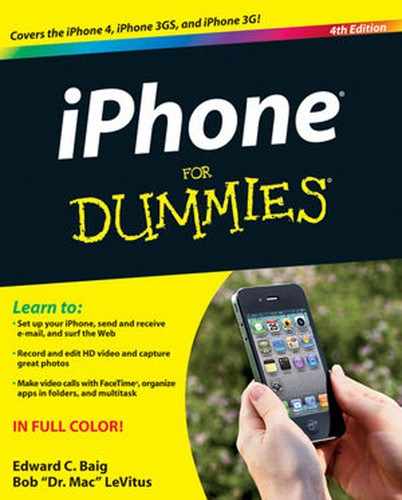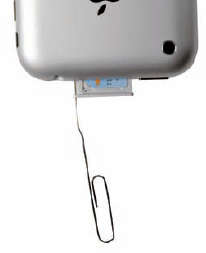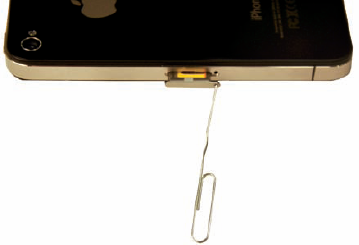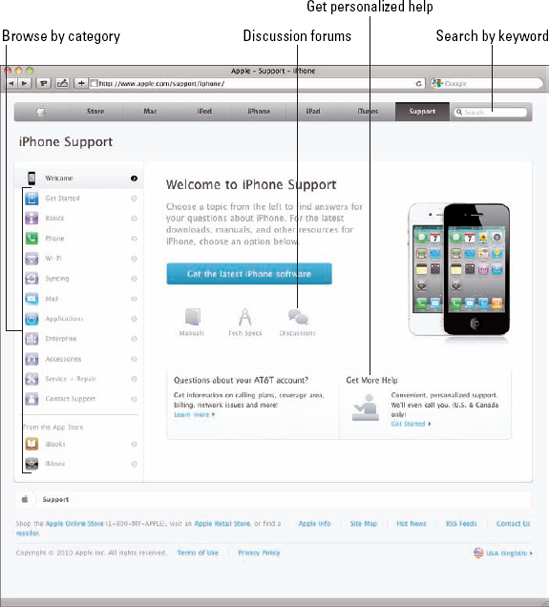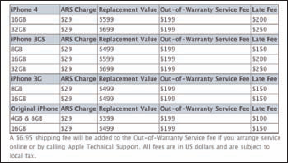In This Chapter
Fixing iPhone issues
Dealing with network and calling problems
Eliminating that sinking feeling when you can't sync
Perusing the Apple Web site and discussion forums
Sending your iPhone to an Apple Store
In our experience, iPhones are usually reliable devices. And, most users we talk to report trouble-free operation. Notice our use of the word most. That's because every so often, a good iPhone goes bad. It's not a common occurrence, but it does happen. So in this chapter, we look at the types of bad things that can happen, along with suggestions for fixing them.
What kind of bad things are we talking about? Well, we're referring to problems involving
The phone itself
Making or receiving calls
Wireless networks
Sync, computers (both Mac and PC), or iTunes

After all the troubleshooting, we tell you how to get even more help if nothing we suggest does the trick. Finally, if your iPhone is so badly hosed that it needs to go back to the mother ship for repairs, we offer ways to survive the experience with a minimum of stress or fuss.
Our first category of troubleshooting techniques applies to an iPhone that's frozen or otherwise acting up. The recommended procedure when this happens is to perform the six Rs in sequence:
Recharge
Restart
Reset your iPhone
Remove your content
Reset settings and content
Restore
If your iPhone acts up on you — if it freezes, doesn't wake up from sleep, doesn't do something it used to do, or in any other way acts improperly — don't panic; this section describes the things you should try, in the order that we (and Apple) recommend.
If the first technique doesn't do the trick, go on to the second. If the second one doesn't work, try the third. And so on.
If your iPhone acts up in any way, shape, or form, the first thing you should try is to give its battery a full recharge.
Note
Don't plug the iPhone's dock connector-to-USB cable into a USB port on your keyboard, monitor, or USB hub. You need to plug the cable into one of the USB ports on your computer itself, because the USB ports on your computer supply more power than the other ports.
Note that you can use the included USB power adapter to recharge your iPhone from an AC outlet rather than from a computer. So if your iPhone isn't charging when you connect it to your computer, try charging it from a wall outlet instead.
If you recharge your iPhone and it still misbehaves, the next thing to try is restarting it. Just as restarting a computer often fixes problems, restarting your iPhone sometimes works wonders.
Here's how to restart:
Slide the red slider to turn off the iPhone, and then wait a few seconds.
Press and hold the sleep/wake button again until the Apple logo appears on the screen.
If your phone is still frozen, misbehaves, or doesn't start, do a force-quit as follows, and then try Steps 1-3 again.
If you have a first-generation iPhone or iPhone 3G, force-quit by pressing and holding the Home button for 6 to 10 seconds.
If you have an iPhone 3GS or 4, force-quit as follows: Press and hold the sleep/wake button until the red Slide to Power Off button appears, and then release the sleep/wake button. Don't drag the red slider. Instead, with the red slider still on the screen, press and hold the Home button for 6 to 15 seconds.
If these steps don't get your iPhone back up and running, move on to the third R, resetting your iPhone.
To reset your iPhone, merely press and hold the sleep/wake button while pressing and holding the Home button on the front. When you see the Appl e logo, you can release both buttons.
Resetting your iPhone is like forcing your computer to restart after a crash. Your data shouldn't be affected by a reset. So don't be shy about giving this technique a try. In many cases, your iPhone goes back to normal after you reset it this way.
Tip
Remember to press and hold both the sleep/wake button and the Home button. If you press both and then release them, you create a screen shot — a picture of whatever is on your screen at the time — rather than reset your iPhone. (This type of screen picture, by the way, is stored in the Photos app's Camera Roll. Find out more about this feature at the end of Chapter 18.)
Unfortunately, sometimes resetting doesn't do the trick. When that's the case, you have to take stronger measures.
If you've been reading along in this chapter, nothing you've done should have taken more than a minute or two. We hate to tell you, but that's about to change because the next thing you should try is removing some or all of your data, to see whether it's the cause of your troubles.
To do so, you need to sync your iPhone and reconfigure it so that some or all of your files are removed from the phone. The problem could be contacts, calendar data, songs, photos, videos, or podcasts. If you suspect a particular data type — for example, you suspect your photos because whenever you tap the Photos icon on the Home screen, your iPhone freezes — try removing that type of data first.
Or, if you have no suspicions, deselect every item on every tab in iTunes (Info, Apps, Music, Movies, Photos, and so on) and then sync. When you're finished, your iPhone should have no data on it.
If that method fixed the problem, try restoring your data, one type at a time. If the problem returns, you have to keep experimenting to determine which particular data type or file is causing the problem.
If you're still having problems, the next step is to reset your iPhone's settings.
Resetting involves two steps: The first one, resetting your iPhone settings, resets every iPhone setting to its default — the way it was when you took it out of the box. Resetting the iPhone's settings doesn't erase any of your data or media. The only downside is that you may have to go back and change some settings afterward, so you can try this step without trepidation. Tap the Settings icon on your Home screen, tap General, tap Reset, and then tap Reset All Settings.
Warning
Be careful not to tap Erase All Content and Settings, at least not yet. Erasing all content takes more time to recover from (because your next sync takes a long time), so try Reset All Settings first.
At this point, you could try resetting some of the other options available on the Reset screen, such as Reset Network Settings, Reset Keyboard Dictionary, Reset Home Screen Layout, or Reset Location Warnings. It's not likely to help but might be worth a try before you resort to erasing all content and settings, as we're about to describe.
Now, if resetting all settings didn't cure your iPhone, you have to try Erase All Content and Settings. (Read the next Warning first.) You find that option in the same place as Reset All Settings (tap Settings, General, and Reset).
Warning
This strategy deletes everything from your iPhone — all your data, media, and settings. Because all these items are stored on your computer — at least in theory — you should be able to put things back the way they were during your next sync. But you lose any photos you've taken, as well as contacts, calendar events, and any playlists you've created or modified since your last sync.
After using Erase All Content and Settings, check to see whether your iPhone works properly. If it doesn't cure what ails your iPhone, the final R, restoring your iPhone using iTunes, can help.
Before you give up the ghost on your poor, sick iPhone, you can try one more thing. Connect your iPhone to your computer as though you were about to sync. But when the iPhone appears in the iTunes source list, click the Restore button on the Summary tab. This action erases all your data and media and resets all your settings.
Note
Because all your data and media still exist on your computer (except for photos you've taken, contacts, calendar events, notes, and playlists you've created or modified since your last sync, or iTunes or App Store content you've purchased or downloaded since your last sync, as noted previously), you shouldn't lose anything by restoring. Your next sync will take longer than usual, and you may have to reset settings you've changed since you got your iPhone. But other than those inconveniences, restoring shouldn't cause you any trouble.
Okay. So that's the gamut of things you can do when your iPhone acts up. If you tried all this and none of it worked, skim through the rest of this chapter to see whether anything else we recommend looks like it might help. If not, your iPhone probably needs to go into the shop for repairs.
Tip
Never fear, gentle reader. Be sure to read the last section in this chapter, "If Nothing We Suggest Works." Your iPhone may be quite sick, but we help ease the pain by sharing some tips on how to minimize the discomfort.
If you're having problems making or receiving calls, problems sending or receiving SMS text messages, or problems with Wi-Fi or your wireless carrier's data network, this section may help. The techniques here are short and sweet — except for the last one, restore. Restore, which we describe in the preceding section, is still inconvenient and time consuming, and it still entails erasing all your data and media and then restoring it.
First, here are some simple steps that may help. Once again, we suggest that you try them in this order (and so does Apple):
Check the cell signal icon in the upper-left corner of the screen.
If you don't have at least one or two bars, you may not be able to use the phone or messaging function.
Make sure you haven't left your iPhone in airplane mode, as described in Chapter 13.
In airplane mode, all network-dependent features are disabled, so you can't make or receive phone calls, send or receive messages, or use any apps that require a Wi-Fi or data network connection (that is, Mail, Safari, Stocks, Maps, and Weather).
Try moving around.
Changing your location by as little as a few feet can sometimes mean the difference between four bars and zero bars or being able to use a Wi-Fi or wireless data network or not. If you're inside, try going outside. If you're outside, try moving 10 or 20 paces in any direction. Keep an eye on the cell signal or Wi-Fi icon as you move around, and stop when you see more bars than you saw before.
Try changing your grip on the phone (or if it's an iPhone 4, try using a case).
Apple says, "Gripping any mobile phone will result in some attenuation of its antenna performance, with certain places being worse than others depending on the placement of the antennas. This is a fact of life for every wireless phone. If you ever experience this on your iPhone 4, avoid gripping it in the lower-left corner in a way that covers both sides of the black strip in the metal band, or simply use one of many available cases."
Turn on airplane mode by tapping Settings on the Home screen, and then tapping the airplane mode On/Off switch to turn it on. Wait 15 or 20 seconds, and then turn it off again.
Note
Toggling airplane mode on and off like this resets both the Wi-Fi and wireless data-network connections. If your network connection was the problem, toggling airplane mode on and off may correct it.
Restart your iPhone.
If you've forgotten how, refer to the "Restart" section, a few pages back. Restarting your iPhone is often all it takes to fix whatever was wrong.
Make sure your SIM card is firmly seated.
Note
A SIM (Subscriber Identity Module) card is a removable smart card used to identify mobile phones. Users can change phones by moving the SIM card from one phone to another.
To remove the SIM card, use the included SIM-eject tool (if you have an iPhone 3G or 3GS), or find a fine-gauge paper clip and straighten one end, and then stick the straight end gently into the hole on the SIM tray, as shown in Figure 15-1 for the iPhone 3G and 3GS and Figure 15-2 for the iPhone 4.
When the SIM tray slides out, carefully lift out the SIM card and then reinsert it, making sure it's firmly situated in the tray before you gently push the tray back in until it locks.
If none of the preceding suggestions fixes your network issues, try restoring your iPhone as described previously, in the "Restore" section.
Warning
Performing a restoredeletes everything on your iPhone — all your data, media, and settings. You should be able to put things back the way they were with your next sync. If that doesn't happen, for whatever reason, you can't say we didn't warn you.
The last category of troubleshooting techniques in this chapter applies to issues that involve synchronization and computer-iPhone relations. If you're having problems syncing or your computer doesn't recognize your iPhone when you connect it, here are some things to try.
Once again, we suggest that you try these procedures in the order they're presented here:
Recharge your iPhone.
If you didn't try it previously, try it now. Go back to the "iPhone Issues" section, at the beginning of this chapter, and read what we say about recharging your iPhone. Every word there applies here.
Try a different USB port or a different cable if you have one available.
It doesn't happen often, but occasionally USB ports and cables go bad. When they do, they invariably cause sync and connection problems. Always make sure that a bad USB port or cable isn't to blame.
If you don't remember what we said about using USB ports on your computer rather than the ones on your keyboard, monitor, or hub, we suggest that you reread the "Recharge" section, earlier in this chapter.
Tip
Apple has used the same USB cable for iPods and iPhones for many years and also uses that same cable for iPads, so if you happen to have one of those cables handy, give it a try.
Restart your iPhone and try to sync again.
We describe restarting in full and loving detail in the "Restart" section, earlier in this chapter.
Restart your computer.
We have found that restarting your computer often fixes issues with syncing your iPhone.
Tip
Restarting your computer can fix non-iPhone issues as well. It's a good idea to reboot your computer before you do any kind of troubleshooting, be it with your iPhone or your computer.
Reinstall iTunes.
If you try everything we suggest earlier in this chapter and still have problems, don't give up just yet. This section describes a few places you may find helpful. We recommend that you check out some or all of them before you throw in the towel and smash your iPhone into tiny little pieces (or ship it back to Apple for repairs, as described in the next section).
First, Apple offers an excellent set of support resources on its Web site at www.apple.com/support/iphone. You can browse support issues by category, search for a problem by keyword, or even get personalized help by phone, as shown in Figure 15-3.
While you're visiting the Apple support pages, another section could be helpful: the discussion forums. You find them at http://discussions.apple.com, and they're chock-full of questions and answers from other iPhone users. Our experience has been that if you can't find an answer to a support question elsewhere, you can often find something helpful in these forums. You can browse by category, such as "Integrating iPhone into Your Digital Life" (part of the "Using iPhone" category), as shown in Figure 15-4, or search by keyword.
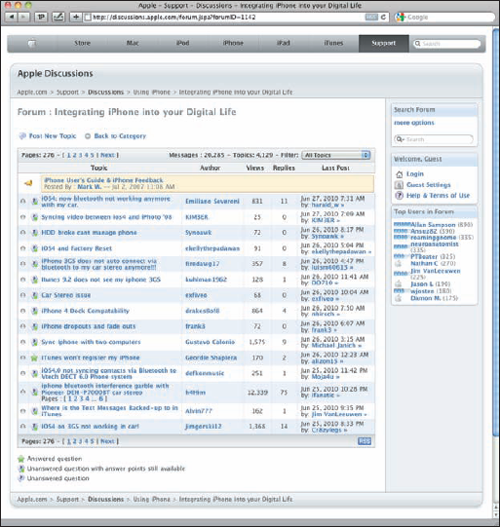
Figure 15.4. Page 1 of 276 pages of discussions about integrating the iPhone into your digital life.
Either way, you find thousands of discussions about almost every aspect of using your iPhone. Better still, frequently you can find the answer to your question or a helpful suggestion.
Now for the best part: If you can't find a solution by browsing or searching, you can post your question in the appropriate Apple discussion forum. Check back in a few days (or even in a few hours), and some helpful iPhone user may well have replied with the answer. If you've never tried this fabulous tool, you're missing out on one of the greatest support resources available anywhere.
Last, but certainly not least, before you give up the ghost, you might want to try a carefully worded Google search. It couldn't hurt, and you might just find the solution you spent hours searching for.
If you tried every trick in the book (this one) and still have a malfunctioning iPhone, it's time to consider shipping it off to the iPhone hospital (better known as Apple, Inc.). The repair is free if your iPhone is still under its one-year limited warranty.
Tip
You can extend your warranty as long as two years from the original purchase date. To do so, you need to buy the AppleCare Protection Plan for your iPhone. You don't have to do it when you buy the phone, but you must buy it before your one-year limited warranty expires. The cost is $69.
Here are a few things you should know before you take your phone in to be repaired:
Your iPhone is erased during its repair, so you should sync your iPhone with iTunes before you take it in, if you can. If you can't and you entered data on the phone since your last sync, such as a contact or an appointment, the data won't be there when you restore your iPhone upon its return.
Remove any third-party accessories, such as a case or screen protector.
Remove the SIM card from your iPhone (as described in the earlier section "Problems with Calling or Networks") and keep it in a safe place.
Warning
Do not, under any circumstances, forget to remove your SIM card. Apple doesn't guarantee that your SIM card will be returned to you after a repair. If you forget this step, Apple suggests that you contact your local AT&T store and obtain a new SIM card with the proper account information. Ouch.
Although you may be able to get your iPhone serviced by AT&T or by mail, we recommend that you take it to your nearest Apple Store, for two reasons:
No one knows your iPhone like Apple. One of the geniuses at the Apple Store may be able to fix whatever is wrong without sending your iPhone away for repairs.
Only the Apple Store offers an Advance Replacement Service (ARS) for iPhones needing repairs. The AppleCare Advance Replacement Service costs $29 when your iPhone is under warranty or covered by the AppleCare Protection Plan. This service provides you with a new iPhone before you have to send in your old one for service.
Warning
If your iPhone isn't under warranty or AppleCare, you can still take advantage of the Advance Replacement Service — it costs you a lot more, though. See Figure 15-5 for the costs at press time or visit www.apple.com/support/iphone/service/exchange for current pricing or more information on the ARS service.
If visiting an Apple or AT&T store isn't possible, call Apple at 1-800-MY-IPHONE (1-800-694-7466) in the United States or visit www.apple.com/contact to find the number to call in other countries.
If you choose the AppleCare Advance Replacement Service, you don't have to activate the new phone and it has the same phone number as the phone it replaces. All you need to do is pop your old SIM card into the new phone, sync it with iTunes to fill it with the data and media files that were on your sick iPhone, and you're good to go.
